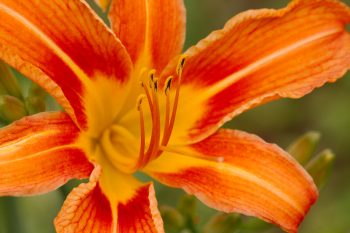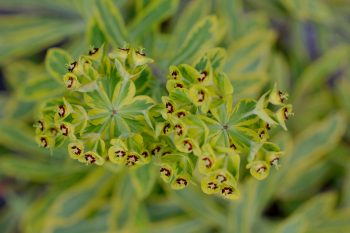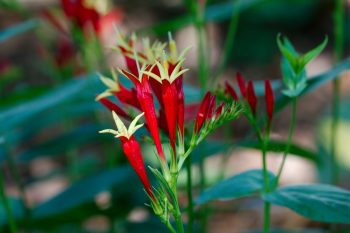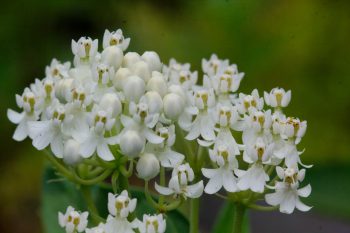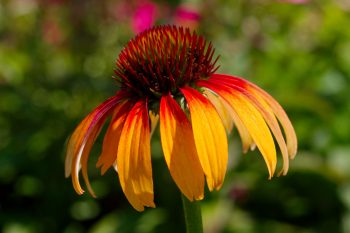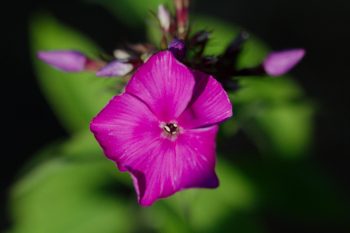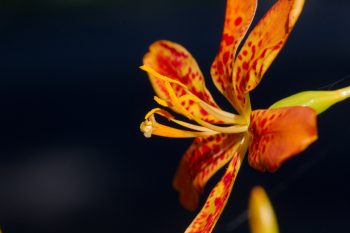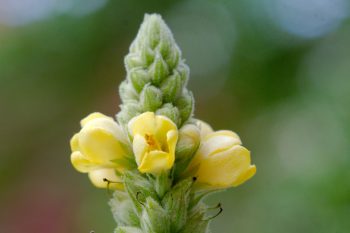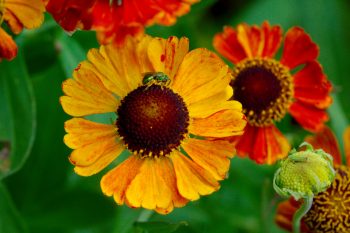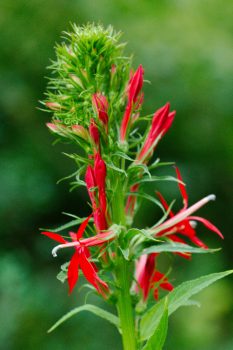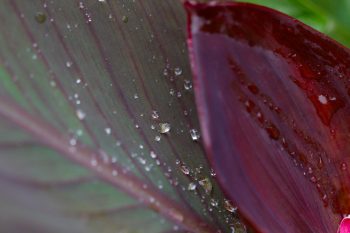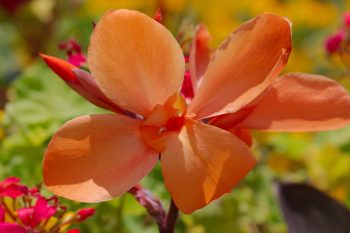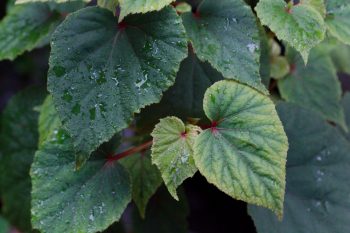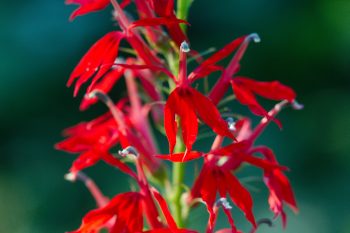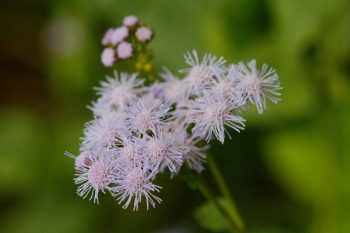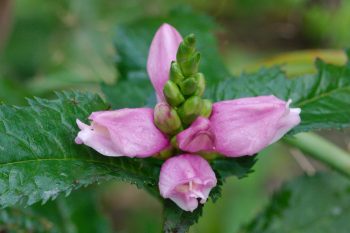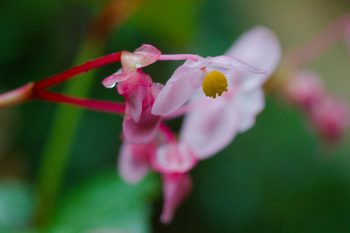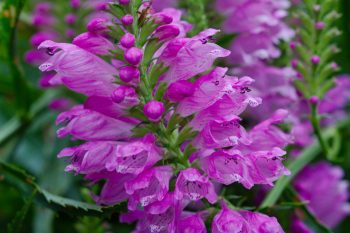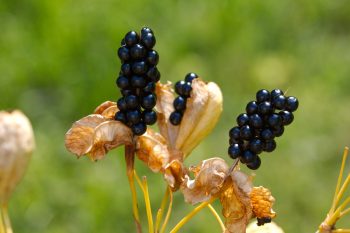The day lilies are starting to bloom. These are descendants from some we dug up in the woods of Pennsylvania, near our property. They are growing around what used to be a homestead, many years ago. There is a hole in the ground with the remains of stone walls and the base of a chimney. Around that are orange day lilies (Hemerocallis fulva) and periwinkle (Vinca minor) growing in great profusion. It’s in the shade as trees have grown up over it and in consequence the day lilies don’t bloom as well as they might, but we took a few home and planted them in the sun, where they bloomed quite happily. That was at our old house and we dug up and brought some of those with us here, where they continue to give a great show every year.
Tagged With: Herbaceous Perennial
Day Lily
Euphorbia amygdaloides subsp. robbiae (Wood Spurge)
I took a few more pictures of plants on Cathy’s work table today. This one is a spurge called Euphorbia amygdaloides subsp. robbiae, also known as Robb’s wood spurge. It’s a nice combination of greens and yellows and something nice for the herbaceous border. The Euphorbia genus has something like 2,000 species and they range from small annual plants to trees and there are species from many parts of the world This one isn’t native to North America, but I’m not bothered by that. One thing you want to be careful of with these plants is their milky sap, which is poisonous if ingested and a skin irritant.
Spigelia marilandica (Indian Pink)
Here’s a second photo for the day. After our walk in the park, we went to the Agricultural Farm Park and walked through their demonstration garden. It’s really changed since we were here last, about two months ago. There was one plant in bloom that really caught our collective eye. It’s a Maryland native commonly called Indian pink (Spigelia marilandica). What a beautiful flower. This is something I’d really like to get. I’ve done some searching and it seems like finding seeds will be difficult. There are a few mail order places that have the plant but most of them ship in the fall. Hopefully I’ll remember to order some then.
Asclepias incarnata ‘Ice Ballet’
We’re big fans of Asclepias and have three species growing in our garden. We have a few varieties of Asclepias curassavica, a tender perennial native to the Caribbean and Central and South America often referred to as blood flower. We have several Asclepias tuberosa, butterfly weed, a hardy perennial native to our region. We just bought a few plants of a variety of Asclepias incarnata called ‘Ice Ballet’. The species is generally pale pink but this variety is a creamy white. It’s also a native to the area and is known as swamp milkweed. These will go in a spot that gets very wet when it rains, as these don’t mind that and there are a lot of things that won’t grow there.
‘Fiery Meadow Mama’ Coneflower
I could see a fairly large garden with nothing but varieties of coneflower (Echinacea species and varieties). One problem we have with them is that the rabbits and deer seem to like them and many that come up have their flowering stem bitten off so we don’t get flowers on them. The few that do bloom are great, of course, but then th bugs get to them and the petals get holes in them. They’re still nice, but not as photogenic. Because of that, we hesitate to buy more coneflowers. This one, called ‘Fiery Meadow Mama’, nearly made me make an exception. Wow, what a flower. There was another called ‘Cone-fections Hot Papaya’ that was mostly red and with a larger center that was nice, too. But we restrained ourselves.
Stock Photo
Over the years I’ve thought about selling photos as stock but I never really got into it. I’m not really sure if I’d actually make any money at it. I sort of doubt it, honestly. I know that now and then I get a reasonably good photo and I certainly enjoy both taking and looking at them. But whether they are actually suitable for stock is another matter. And of course it isn’t just that. They would have to be found among the hundreds of thousands of other stock photos. I’m sure there are ways to increase your chances but I’m not sure I care enough. So, I’ll just stick to what I do and occasionally post a photo with an attempt at a clever title. This is stock, Matthiola incana.
Iris domestica (Blackberry Lily)
The blackberry lily (Iris domestica, formerly known as Belamcanda chinensis, has beautiful, bright orange flowers above an attractive fan of sword-shaped leaves. It spreads slowly into clumps but mostly spreads by seed, which are distributed both by birds and by wives who really like it in our garden. I first collected seeds in South Carolina many, many years ago and we’ve had it around ever since. We have quite a few at this point and we may be reaching the time when a few of them need to be pulled up (but I’m not sure Cathy’s ready for that yet). They are native from the Himalayas to the Russian far east but do very well here. I like the lighting in this. The bloom is in full sun and the background is the pavement of our street in shadow.
Verbascum thapsus (Common Mullein)
This is the tip of a mullein stalk growing up close to the front of our house. It’s not really in a place I’d choose to plant it, but I left it there for Cathy. She really likes it and we have a fair amount in the hawthorn bed that has become something of a Mediterranean garden this year. It’s funny to hear so many people praise this plant as something the native Americans used medicinally. It may be true, but that only happened after it was introduced from Europe, as it isn’t a native American itself. It’s quite hardy (USDA Zones 3 to 9) and is quite happy in dry, otherwise barren places. This part of our yard really dries out in the summer and is currently rock hard. But along with the Verbascum we have Verbena bonariensis (tall verbena), Lavandula stoechas (Spanish lavender), and Salvia rosmarinus (rosemary), which all do well in rather severe conditions and in fact don’t like being waterlogged.
Sneezeweed (Helenium ‘Mardi Gras’)
Cathy bought a few perennials over the weekend and I planted this one yesterday. It’s a sneezeweed called ‘Mardi Gras’ and it’s really nice. The flowers have a similar look to black-eyed Susans but it’s a different genus (Helenium). I happened to catch it with a little, green-sweat bee on it, which is a bonus. It prefers somewhat barren ground and isn’t supposed to do well in heavy clay, which is probably why I haven’t seen it around here. That’s really all we have. But hopefully it will survive, even if it doesn’t thrive too well.
Tiger Lily (Lilium Lancifolium)
This won’t be the only photo I post of these, I suspect. They are starting to bloom and are already quite spectacular but when they really get into full bloom, with 20 or more flowers per stem, they are amazing. The seem to deal pretty well with the sweltering heat we’ve had and the occasional downpour. The biggest threat to them, actually, is deer, which will come in and eat them. We’ve been fortunate this year and only a few stems have been cut off (and that may be rabbits). We have them in a few places around the yard but the most conspicuous are in the front, right out near the road, where there used to be a large oak tree (until it died and the county cut it down).
Cardinal Flower (Lobelia cardinalis)
I probably should have waited a little longer to take a picture of this, since it isn’t really in full bloom yet. But I only got outside for a little while late this afternoon and this is all I took photos of. Cardinal flower (Lobelia cardinalis), is an American native and well worth growing. It really adds a splash of bright color to the garden. The only thing here is that you need to watch it in our dry summer heat that it doesn’t dry out too much. It likes moist soil and can even tolerate a little brief flooding. If you’re in a place that’s not quite so hot in the summer, you could plant it in full sun but for us, it does better with a bit of shade. This one is growing under a largish cherry tree and it a bit protected from the hot, afternoon sun. If you have a stream or pond, this would be great on the banks of that. Ours will have more flowers in a matter of days but you can already see how red the blooms are and why it’s such a nice thing in the border. We should have more than we do.
Canna Leaves
I took Dorothy to the airport this morning. It was raining so the traffic was a bit slow but other wise no problem. It continued to rain the rest of the day and I only got out for a little while to take pictures. These are canna leaves with water droplets on them. The canna is (her the Missouri Botanical Garden’s Plant Finder):
a genus of around 10 species of rhizomatous, tropical and subtropical, herbaceous perennials that produce flower spikes in summer atop erect stems sheathed in large paddle-shaped leaves. Cultivars are available with colorful foliage and flowers in a range of warm colors including red, orange, yellow, pink, and creamy white.
Canna Lily
Cathy planted two canna lilies this spring in a container on the back patio. Our patio is generally nice in the summer, with a collection of plants in containers as well as the black-eyed Susans that surround it. This year is, I think, the best it’s ever been. This canna lily is part of the reason. It’s so bright and especially when back-lit, the dark leaves add an additional contrast. The patio is a riot of colors, with the Pelargonium right behind the canna and with all sorts of other flowers of a wide variety of colors. Definitely nice to have. We’re so fortunate.
Begonia grandis (Hardy Begonia)
Cathy has this hardy begonia (Begonia grandis) growing a few places around the house. It really seems to like the relatively shady area around our front door, which gets a little morning sun but that’s it. And even that is filtered through the foundation planting. It seems particularly happy this year, with the amount of rain we’ve had. It’s just coming into bloom, with its delicate and interestingly shaped, pink flowers. But I think it’s worth having just the leaves. We have a few little seedlings that Cathy has collected and she will try to get a few established in new places.
Cardinal Flower (Lobelia cardinalis)
There’s a lot in bloom right now, but there’s actually less variety than there was earlier in the year. The garden is full of black-eyed Susan and there are other, less showy flowers, like the mountain mint, which attracts so many pollinators. Around on the side of the house, in the shadier part of the garden, we have this cardinal flower (Lobelia cardinalis), which is absolutely stunning. The red is so pure and bright, especially when the sun is on it. Cathy saw a hummingbird come to this, as well, which is exciting. I suppose I should have posted a photo of the two of us, for our anniversary, but flowers are where it’s at.
Conoclinium coelestinum (Blue Mistflower)
We picked up some blue mistflower (Conoclinium coelestinum) along with some other plants that were being given to us. It’s spread around the yard and now we have both the normal pale blue, as seen here (it’s more blue than this photo makes it look) and a white sport (or perhaps the blue is the sport). It blooms late in the summer, just starting now, and will be around into the fall. I don’t know that I’d run out an buy any, but it’s not bad to have a late summer bloomer in the garden. The skippers tend to be the most common pollinators on it, but the bees go to it some, too.
Chelone lyonii (Pink Turtlehead)
We’ve only had this native perennial a few years and this is by far the best it’s done in our garden. We have it in a somewhat shady area. Over time it should spread and form a clump, although not so much that it could be considered invasive (like much of what we have). The snapdragon-like flowers are fairly large and as you can see, they are borne in tight, spike-like terminal racemes. They are actually native to a bit further south than we are but have become naturalized over much of the east coast.
Begonia grandis (Hardy Begonia)
I had a picture of the leaves of this Hardy Begonia (Begonia grandis) earlier this month. Now it’s in bloom and adding a little brightness to the shady spot outside our front door. It’s a great plant to have and looks like it shouldn’t be sturdy enough to survive our winters but it does and it actually does quite well. It won’t grow well too far to our south because of the heat of summer or too far to the north because of the cold winters, but here it’s quite reliable. Highly recommended.
Physostegia virginiana
We have a patch of Physostegia virginiana (obedient plant) in the back border. This area of the garden was one of the worst in terms of being out of control and we did a lot of digging there this year. Cathy did most of it, although I did help a bit with some of the deeper digging. It was overrun with goldenrod (Solidago) and mugwort (Artemisia vulgaris), which we wanted to get rid of completely, but even the things we grew on purpose, like the Monarda and this Physostegia, were out of control and needed to be thinned out. So, we still have this, but less than we did. It’s a fairly aggressive perennial, spreading by both rhizomes and by self-seeding. So, grow with caution.
Iris domestica (Blackberry Lily)
Native to the Himalayas and the Russian far east, the blackberry lily (Iris domestica, formerly known as Belamcanda chinensis), is a lovely and well behaved herbaceous perennial. It self-seeds pretty well and we promote that by distributing the seeds fairly widely. We’re getting to the point where we might actually pull a few up if they aren’t where we want them, but generally we let them go wherever they come up. They have wonderful, bright orange flowers in succession during the early summer and then the fruit ripens in pods that open up to reveal the “blackberries” that give the plant its common name.

